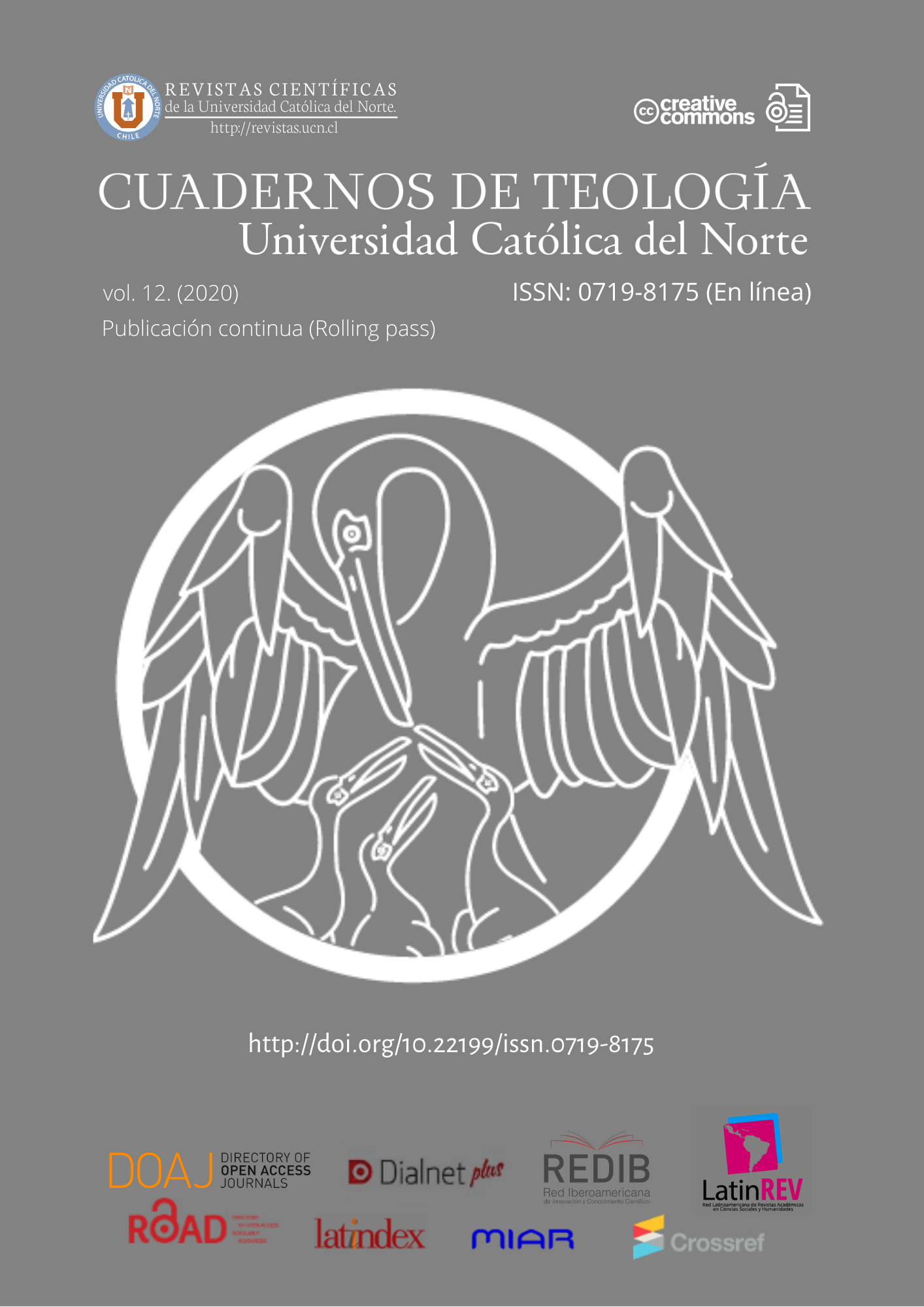The sign of the sea:
a biblical-theological interpretation Ex 14
DOI:
https://doi.org/10.22199/issn.0719-8175-2020-0011Keywords:
Red Sea, Miracle, Historical-critical method, CreationAbstract
The objective is aims to carry out a biblical-theological interpretation of the miracle of the sea, for which Exodus 14 is advocated from a critical historical perspective and a theological reading is made that provides for an understanding of the miracle of the sea beyond a magical interventionism from God. To carry out this research, a qualitative-documentary methodology is used, since a bibliographic review was made, to hermeneutically justify the biblical-theological approach to the perícopa in question. The main findings lead to the conclusion that Exodus 14 has several editorial layers, which clarifies the apparent contradictions; likewise, it is agreed that the miracle is not a divine interventionism that breaks the laws of nature, but is the discovery, by the affirmative force of faith, of God's action in the world.
References
Al-Arifi, N. S., Lashin, A. A., y Al-Humidan, S. (2012). Migration of local earthquakes in the Gulf of Aqaba, North Red Sea. Earth Sciences Research Journal, 16(1), 35–40. https://bit.ly/2MehMBk
Alexander, T. D. (1995). From Paradise to the Promised Land. An Introduction to the Main Themes of the Pentateuch. Carlisle U.K.: Paternoster Press.
Alonso Schökel, L. (s.f.). Biblia del peregrino (Vol. 1). Estella: Verbo Divino.
Alonso Schökel, A., Mateos, J., Benito, A., Gil Modrego, A., y Múgica, J. A. (Trads.). (1970). Pentateuco: Génesis- Éxodo (Vol. 1). Madrid: Cristiandad.
Álvarez, A. (2002). ¿Cómo cruzaron los israelitas el Mar Rojo?. Cuestiones Teológicas y Filosóficas, 29(72), 407-412.
Auzou, G. (1996). De la salvación al servicio: estudio del libro del Éxodo. Madrid: Fax.
Azaryahu, M. (2005). The beach at the end of the world: Eilat in Israeli popular culture. Social & Cultural Geography, 6(1), 117–133. https://doi.org/10.1080/1464936052000335008
Batayneh, A. T. (2007). Mapping subsurface formations on the Eastern Red Sea Coast in Jordan using geoelectrical techniques: geological and hydrogeological implications. Earth Sciences Research Journal, 11(2), 97–107. https://bit.ly/2X07d76
Benedicto XVI. Vaticano II. Exhortación Apostólica Postsinodal Verbum Domini. 30 de septiembre de 2010. https://bit.ly/3n3uAaH
Berder, M., Birnbaum, M., Delattre, B., Cousin, H., Déclais, J. L., Etaix, R., Gruson, P. y Meunier, B. (1998). La Pascua y el paso del mar en las interpretaciones judías, cristianas y musulmanas (Éx 12-14) (J. P. Tosaus, Trad.). Estella: Verbo Divino.
Bergoeing, J. P. (2015). Riesgo volcánico en la Península Árabe. Revista Geográfica, (156), 43–52. https://bit.ly/3pD6fKf
Blenkinsopp, J. (1999). El pentateuco: introducción a los cinco primeros libros de la Biblia. Estella: Verbo Divino.
Borgonovo, G., Balzaretti, C., Barbiero, G., Boschi, G. B., Cardellino, I., Mazzinghi, L., Nobile, M. y Ska, J. L. (2012). Torah e storiografie dellAntico Testamento. Torino: Elledici.
Bultmann, R. (1973). Nuovo testamento e mitología. Brescia: Queriniana.
Campbell, A. F. y O’Brien, M. A. (1993). Sources of the Pentateuch: texts, introductions, annotations. Minneapolis: Fortress Press.
Campbell, A. F. y O’Brien, M. A. (2005). Rethinking the Pentateuch: prolegomena to the Theology of Ancient Israel. Westminster: John Knox Press.
Camus, A. (1973). El mito de Sísifo. (Vol. 2, Obras Completas). México: Aguilar.
Cardona, H. (2002). Los signos en la Biblia: una aproximación bíblico teológica. Cuestiones teológicas y filosóficas, 28(69), 71-115.
Coogan, M. D. (2006). The Old Testament: a historical and literary introduction to the Hebrew Scriptures, Oxford: Oxford University Press.
Couto, A. (2003). Pentateuco: caminho da vida agraciada, Lisboa: Universidade Católica Editora.
De Vaux, R. (1971). Historia antigua de Israel (Vol. 1). Madrid: Cristiandad.
Erdozain, L. (2002). Los milagros. Estudios Eclesiásticos, 77(300), 141–162. https://bit.ly/3pD2LYb
Farmur, A., Levoratti, A., Eugnue, S., y Dungan. (1999). Comentario internacional. Estella: Verbo Divino.
Fretheim, T. E. (1996). The Pentateuch. Nashville: Abingdon Press.
Galvagno, G. y Giuntoli, F. (2014). Dai frammenti alla storia: introduzione al Pentateuco. Torino: Elledici.
García López, F. (2003). El Pentateuco. Estella: Verbo Divino.
Garduño García, M. (2019). Arabia Saudí y las dinámicas de financiarización en Oriente Medio: algunas repercusiones geopolíticas del proyecto Neom en el Mar Rojo. Relaciones Internacionales, (42), 141–156. https://doi.org/10.15366/relacionesinternacionales2019.42.008
Hyslop, H. (1983). Un método popular para discernir los milagros. Scripta Theologica, 15(1), 143–151. https://doi.org/10.15581/006.15.1.143-152
Levoratti, A, J. (Dir.), Tamez, E. y Richard, P. (Colab.). (2003). Comentario bíblico latinoamericano. Estella: Verbo Divino.
Missimer, T., Hoppe-Jones, C., Jadoon, K., Li, D., y Al-Mashharawi, S. (2014). Hydrogeology, water quality, and microbial assessment of a coastal alluvial aquifer in western Saudi Arabia: potential use of coastal wadi aquifers for desalination water supplies. Hydrogeology journal, 22(8), 1921–1934. https://doi.org/10.1007/s10040-014-1168-3
Morales, J. (1970). El milagro en la teología contemporánea. Scripta Theologica, 2(1), 195–220. https://doi.org/10.15581/006.2.1.195-220
Nolan, A. (1981). “¿Quién es este hombre?” Jesús antes del cristianismo. Santander: Sal Terrae.
Pinto, K. (2017). In God’s Eyes: the sacrality of the seas in the Islamic cartographic vision. Espacio, tiempo y forma. Serie VII, Historia del arte, (5), 55–79. https://doi.org/10.5944/etfvii.5.2017.18131
Sartre, J. (1985). El existencialismo es un humanismo. Barcelona: Obris, S.A.
Settembrini, M. (2012). Nel Pentateuco: introduzione ai primi cinque libri della Bibbia. Cinisello Balsamo: San Paolo.
Ska, J. (2001). Introducción a la lectura del Pentateuco. Claves para la interpretación de los cinco primeros libros de la Biblia. Estella: Verbo Divino.
Tallet, P. (2017). Tres puertos egipcios en el Mar Rojo durante el período faraónico : una reevaluación de la evidencia. Antiguo Oriente, 15, 175–194. https://bit.ly/2WZZjdW
Tillich, P. (1970). Amor, poder y justicia; análisis ontológicos y aplicaciones éticas. Barcelona: Ariel.
Torres, A. (1986). Creo en Dios Padre: el Dios de Jesús como afirmación plena del hombre. Santander: Sal Terrae.
Torres, A. (1996). Repensar la cristología: sondeos hacia un nuevo paradigma. Estella: Verbo Divino.
Torres, A. (2000). Fin del cristianismo premoderno: retos hacia un nuevo horizonte. Santander: Sal Terrae.
Varo, F. (2016). Pentateuco y libros históricos. Pamplona: EUNSA.
von Rad, G. (1972). Teología del Antiguo Testamento (Vol. 1). Salamanca: Sígueme.
Wood, W. W. (2011). Source of paleo-groundwater in the Emirate of Abu Dhabi, United Arab Emirates: evidence from unusual oxygen and deuterium isotope data. Hydrogeology journal, 19(1), 155–161. https://doi.org/10.1007/s10040-010-0626-9
Published
How to Cite
Issue
Section
Copyright (c) 2020 Carlos Alberto Vargas González

This work is licensed under a Creative Commons Attribution 4.0 International License.
Los autores continúan como propietarios de sus trabajos, y pueden volver a publicar sus artículos en otro medio sin tener que solicitar autorización, siempre y cuando indiquen que el trabajo fue publicado originariamente en Revista Cuadernos de Teología (eISSN:0719-8175).












_(1).png)






